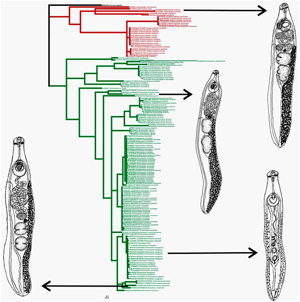Published online by Cambridge University Press: 09 June 2021

Life cycles, and morphological and molecular data were obtained for Echinostoma chankensis nom. nov., Echinostoma cinetorchis, Echinostoma miyagawai and Isthmiophora hortensis from East Asia. It was established that, based on both life cycle and morphology data, one of the trematodes is identical to the worms designated as Euparyphium amurensis. Genetic data showed that this trematode belongs to Echinostoma. The complex data on biological, morphological and genetic characterizations establish that the distribution of the morphologically similar species, I. hortensis and Isthmiophora melis, in the Old World are limited by the East Asian and European regions, respectively. Data on mature worms of East Asian E. miyagawai revealed morphological and genetic identity with E. miyagawai from Europe. However, E. miyagawai from Europe differs from E. miyagawai from the type locality (East Asia) in terms of reaching maturity and the morphology of cercariae. These data indicate that the European worm, designated E. miyagawai, does not belong to this species. An analysis of the phylogenetic relationships of Echinostomatidae was conducted based on the 28S, ITS2 and nad1 markers. Analysis using the nad1 gene for the known representatives of Echinostomatidae is carried out for the first time, showing that nuclear markers are ineffective separate from mitochondrial ones.